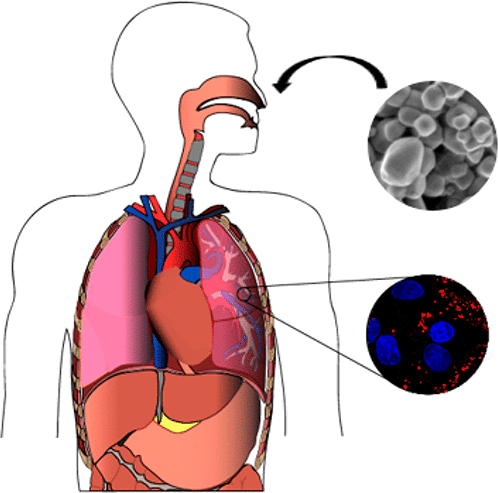当前位置:
X-MOL 学术
›
J. Phys. Chem. B
›
论文详情
Our official English website, www.x-mol.net, welcomes your
feedback! (Note: you will need to create a separate account there.)
Nanoparticle–Cell Interactions: Relevance for Public Health
The Journal of Physical Chemistry B ( IF 2.8 ) Pub Date : 2017-11-21 00:00:00 , DOI: 10.1021/acs.jpcb.7b08650 Sabiha Runa 1 , Michael Hussey 2 , Christine K. Payne 1, 3
The Journal of Physical Chemistry B ( IF 2.8 ) Pub Date : 2017-11-21 00:00:00 , DOI: 10.1021/acs.jpcb.7b08650 Sabiha Runa 1 , Michael Hussey 2 , Christine K. Payne 1, 3
Affiliation

|
Nanoparticles, especially metal oxide nanoparticles, are used in a wide range of commercial and industrial applications that result in direct human contact, such as titanium dioxide nanoparticles in paints, food colorings, and cosmetics, or indirectly through release of nanoparticle-containing materials into the environment. Workers who process nanoparticles for downstream applications are exposed to especially high concentrations of nanoparticles. For physical chemists, nanoparticles present an interesting area of study as the small size of nanoparticles changes the properties from that of the bulk material, leading to novel properties and reactivity. For the public health community, this reduction in particle size means that exposure limits and outcomes that were determined from bulk material properties are not necessarily valid. Informed determination of exposure limits requires a fundamental understanding of how nanoparticles interact with cells. This Feature Article highlights the areas of intersection between physical chemistry and public health in understanding nanoparticle–cell interactions, with a focus on titanium dioxide nanoparticles. It provides an overview of recent research examining the interaction of titanium dioxide nanoparticles with cells in the absence of UV light and provides recommendations for additional nanoparticle–cell research in which physical chemistry expertise could help to inform the public health community.
中文翻译:

纳米颗粒与细胞的相互作用:与公共卫生的关系
纳米粒子,尤其是金属氧化物纳米粒子,被广泛用于导致人类直接接触的商业和工业应用中,例如油漆,食用色素和化妆品中的二氧化钛纳米粒子,或通过将含纳米粒子的材料释放到人体中而间接地使用。环境。为下游应用加工纳米颗粒的工人暴露于特别高浓度的纳米颗粒中。对于物理化学家来说,纳米粒子是一个有趣的研究领域,因为小尺寸的纳米粒子改变了本体材料的性能,从而带来了新颖的性能和反应性。对于公共卫生界来说,这种减小的粒径意味着根据散装材料特性确定的暴露极限和结局不一定有效。知情确定暴露极限需要对纳米颗粒如何与细胞相互作用有基本的了解。这篇专题文章重点介绍了物理化学与公共卫生之间在理解纳米粒子与细胞相互作用方面的交叉领域,重点是二氧化钛纳米粒子。它概述了近期研究在没有紫外线的情况下研究二氧化钛纳米粒子与细胞相互作用的研究,并为其他纳米粒子-细胞研究提供了建议,在这些研究中,物理化学专业知识可以帮助向公共卫生界提供信息。这篇专题文章重点介绍了物理化学与公共卫生之间在理解纳米粒子与细胞相互作用方面的交叉领域,重点是二氧化钛纳米粒子。它概述了近期研究在没有紫外线的情况下研究二氧化钛纳米粒子与细胞相互作用的研究,并为其他纳米粒子-细胞研究提供了建议,在这些研究中,物理化学专业知识可以帮助向公共卫生界提供信息。这篇专题文章着重介绍了物理化学与公共卫生之间在理解纳米颗粒与细胞相互作用方面的交叉领域,重点是二氧化钛纳米颗粒。它概述了近期研究在没有紫外线的情况下研究二氧化钛纳米粒子与细胞相互作用的研究,并为其他纳米粒子-细胞研究提供了建议,在这些研究中,物理化学专业知识可以帮助向公共卫生界提供信息。
更新日期:2017-11-21
中文翻译:

纳米颗粒与细胞的相互作用:与公共卫生的关系
纳米粒子,尤其是金属氧化物纳米粒子,被广泛用于导致人类直接接触的商业和工业应用中,例如油漆,食用色素和化妆品中的二氧化钛纳米粒子,或通过将含纳米粒子的材料释放到人体中而间接地使用。环境。为下游应用加工纳米颗粒的工人暴露于特别高浓度的纳米颗粒中。对于物理化学家来说,纳米粒子是一个有趣的研究领域,因为小尺寸的纳米粒子改变了本体材料的性能,从而带来了新颖的性能和反应性。对于公共卫生界来说,这种减小的粒径意味着根据散装材料特性确定的暴露极限和结局不一定有效。知情确定暴露极限需要对纳米颗粒如何与细胞相互作用有基本的了解。这篇专题文章重点介绍了物理化学与公共卫生之间在理解纳米粒子与细胞相互作用方面的交叉领域,重点是二氧化钛纳米粒子。它概述了近期研究在没有紫外线的情况下研究二氧化钛纳米粒子与细胞相互作用的研究,并为其他纳米粒子-细胞研究提供了建议,在这些研究中,物理化学专业知识可以帮助向公共卫生界提供信息。这篇专题文章重点介绍了物理化学与公共卫生之间在理解纳米粒子与细胞相互作用方面的交叉领域,重点是二氧化钛纳米粒子。它概述了近期研究在没有紫外线的情况下研究二氧化钛纳米粒子与细胞相互作用的研究,并为其他纳米粒子-细胞研究提供了建议,在这些研究中,物理化学专业知识可以帮助向公共卫生界提供信息。这篇专题文章着重介绍了物理化学与公共卫生之间在理解纳米颗粒与细胞相互作用方面的交叉领域,重点是二氧化钛纳米颗粒。它概述了近期研究在没有紫外线的情况下研究二氧化钛纳米粒子与细胞相互作用的研究,并为其他纳米粒子-细胞研究提供了建议,在这些研究中,物理化学专业知识可以帮助向公共卫生界提供信息。







































 京公网安备 11010802027423号
京公网安备 11010802027423号